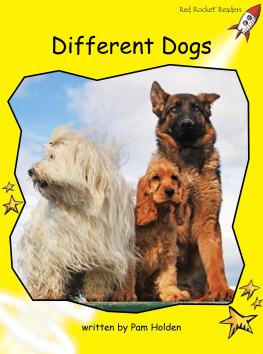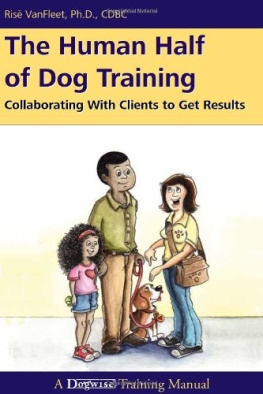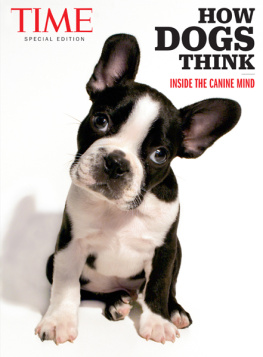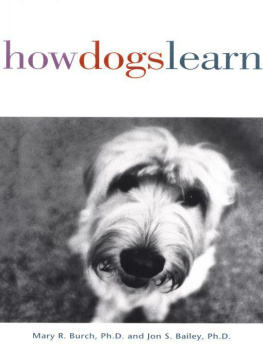Do As I Do
Using Social Learning to Train Dogs
Claudia Fugazza
Dogwise Publishing
A Division of Direct Book Service, Inc.
403 South Mission Street, Wenatchee, Washington 98801
1-509-663-9115, 1-800-776-2665
Original version of this book and dvd entitled Do As I Do, Il cane impara guardandoci was published in Italy by Haqihana in 2011.
2014 Claudia Fugazza. English language version of book and DVD published by Dogwise Publishing with permission of Haqihana.
Photos: Claudia Fugazza and Federica Lazza. Reprinted with permission of Haqihana.
Graphic design: Lindsay Peternell
All rights reserved. No part of this book may be reproduced or transmitted in any form or by any means, electronic, digital or mechanical, including photocopying, recording or by any information storage or retrieval system without permission in writing from the publisher.
Limits of Liability and Disclaimer of Warranty:
The author and publisher shall not be liable in the event of incidental or consequential damages in connection with, or arising out of, the furnishing, performance, or use of the instructions and suggestions contained in this book.
Library of Congress Cataloging-in-Publication Data
Fugazza, Claudia, 1978
Do as I do : using social learning to train dogs / by Claudia Fugazza.
pages cm
Includes index.
ISBN 978-1-61781-148-7
1. Dogs--Training. 2. Dogs--Psychology. 3. Social learning. I. Title.
SF431.F84 2014
636.70835--dc23
2014014123
ISBN: 978-1-61781-148-7
Printed in the U.S.A.
Dedication
This book is dedicated to my beloved India, life companion and soul mate, friend and eternal source of inspiration.
The intimate bond we shared for years, the experiences and promises, the memories mutually interwoven render living without you even more difficult.
However, it was precisely from what existed between the two of us that grew the ideas and thoughts behind my research. This book also exists because of you.
Nacchera, you will always live within me.
Table of Contents
Acknowledgments
An immense thank you (and a tasty reward) to India for embarking on this journey with me, and to all the dogs and owners who have participated in our studies for allowing us to discover a bit of their minds.
I am also grateful to my mother, whose literary skills greatly contributed to improving the draft of this book.
A special acknowledgment goes to Professor Adam Miklsi from the Ethology Department at the University of Budapest for helping me to elaborate the various projects within my research line.
And last but not least thank you to my partner for supporting me and standing with me while I was so busy with my research that I even forgot about eating.
There are two types of people in the world. Some of them believe that dogs are not able to imitate humans; others are convinced that dogs readily copy human behavior. Perhaps this is the place where I should admit that I had belonged to the former group of people for many years, before Jzsef Topl and I dared to test this idea of imitation in dogs for the first time, some years ago. I did not have much to losebeing a non-believer anywayso it came to me as a huge surprise that Philip, a well-trained Belgian Shepherd assistance dog for the disabled, showed clear signs of imitation abilities after some weeks of training.
I also have vivid memories about getting back the reviewers comments on our first draft paper describing the Do As I Do method and the impressive results with Philip. Their comments were longer than the manuscript, and of course it was clear that these fellow researchers were non-believerslike meso it is highly likely that I would have also been critical if I had been in the same situation. But Philips performance did not leave room for any doubt! A few years later we managed to train some more dogs by means of the same method, the result being that there was no doubt that these other dogs were able to show functional imitation of human behavior without any special training, just like Philip.
Although I came to think that the Do As I Do method could be a useful way to extend the training of dogs (and owners), it was Claudia Fugazzas courage and persistence that was the key factor in developing this new method for the wider dog-loving audience. I hope this book is only the first step to introduce the Do As I Do method to dog trainers and dog owners, and I am sure that Claudia will have many more ideas to develop this method further and further. This book provides a very nice and helpful introduction to the concept of social learning and also explains in detail how Do As I Do training should be performed.
I have always been a bit annoyed that dog trainingas the term impliesfocuses on the dog, while actually it should be about synchronization of the behavior of dog and owner. Just like dancing is not about man-training (most women have a natural talent for dancing anyway!) but is about learning how to move together in a synchronized fashion. The same applies to the Do As I Do method. Owners or trainers become equal partners with their dogs, and they can experience and feel what the execution of a specific action means for their companion. Relying on the Do As I Do method gives dog training a real social flavor, makes it more enjoyable and more fun.
Apart from this, the Do As I Do method offers an easy way to teach new types of actions with relatively little effort on the part of the dog. They may not be able to execute behaviors precisely the first time, but you can see they can grasp the concept. Claudia Fugazza and I showed that this method is at least as good as other, traditional methods of dog training. And there is no need to abandon your old methods; just teach Do As I Do to your dog as a complementary way of social interaction.
Let me end by sharing a new idea with you. By watching puppies interact with each other, you can see how much they want to engage in group activities, including performing similar actions that they see the other puppies perform. Based on this, I have come to believe that the way dogs learn from each other is a basic skill activated very early in development. The main problem is that, in most cases, we humans get them out of this habit by not encouraging such activities. Dogs should not dig when the owner is digging or open the refrigerator after seeing the owner doing it! So the Do As I Do method simply awakens a natural skill in the dog and puts some human control over his synchronizing tendencies. Thus dogs who are allowed to imitate their owners will love doing it and have a happier lifeso give it a try... You can do itas we did!
Adam Miklsi, Professor of Ethology
Family Dog Project, Budapest, Hungary
I made the decision to write this book in order to help spread a new training method that takes advantage of the social learning skills of dogs and their predisposition to learn by observing, and then imitating and/or repeating behaviors, performed by humans. Interestingly, despite the fact it is now well known that dogs have excellent social learning skills, training methods used so far have not relied on their ability to learn by observation and imitation.
Traditionally, the techniques used for dog training have been based on individual associative learning, that is, operant and classical (Pavlovian) conditioning. Almost every species has the skill to learn, e.g., through association, even very simple organisms as well as those who do not live in complex social structures like packs and families. But I have always been curious to know if my dogs learn to open doors on their own by simple associative learning, for instance by trial and error, or whether it is by a different process reflecting their eminently social nature and their great observational skills. I am sure that many dog owners have noticed the inclination of dogs to be curious and attracted toward what we humans do and the objects we handle. How many of us have bedded plants out in the garden with great care under a dogs scrutiny, digging a small hole, introducing the roots and lovingly covering them with fresh soil, only to find out later on that the dog has pulled the plants out and perhaps even meticulously dug up the entire garden. While we were digging, Fido probably thought that it was an interesting game and that he wanted his share of the fun. It seems to me that the question that needs to be addressed is whether dogs can learn through the use of social learning, observing and then replicating the actions of their human companions.











